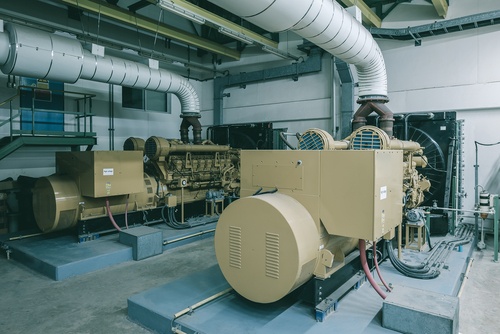What Additional Components Does an Emergency Generator Need?

The NYC Building Code makes emergency generators mandatory for various building systems, in both residential and commercial settings. There are also cases where a generator is requested directly by the client for optional applications. However, keep in mind that generators must always be code-compliant, even when their use is optional.
Although the generator is the cornerstone of an emergency power system, additional components are required for safe and reliable operation. A generator room also contains the following elements:
- Fuel tank
- Exhaust system
- Radiator
In section 24-109, the NYC Administrative Code requires all emergency generators to be registered with the Department of Environmental Protection. Using an unregistered generator is against the law, even if the unit is installed according to code requirements.
Does your building have a reliable emergency power system?
What Is an Emergency Generator?
An emergency generator provides an electricity output using a fuel input, most commonly diesel. The device combines a diesel engine and an electric generator: fuel combustion drives the engine, and the rotational motion of the shaft drives the generator. There are also generators designed for other fuels such as natural gas, although they are less common.
Diesel generators normally have a higher kilowatt-hour cost than the power grid supply, which limits their use to blackouts and off-grid locations. To achieve optimal performance at a reasonable cost, proper sizing is very important:
- An undersized generator is often taken to the limit, which trips the circuit breaker. When an emergency power system gets disconnected frequently, it defeats its own purpose.
- Oversized generators are inefficient, and their unused capacity represents a waste of capital.
In buildings where the power bill is calculated based on both capacity and demand, generators can be used for peak shaving: they come online during high-demand periods to minimize the peak measured by the utility company, lowering the power bill. Of course, peak shaving is only viable if the generator running cost is lower than the savings from peak demand reduction.
Generation systems with a production cost below the electricity tariff can export surplus kilowatt-hours in exchange for credit. Commercial and industrial clients with large generators may also be called to provide grid support services like voltage and frequency stabilization.
You may have heard the term “genset” when dealing with backup power systems, which stands for “generating set”. The concept is often used to describe any generator, but it actually refers to a packaged unit with including ancillary devices like a base, canopy, sound attenuation system, controls, electrical protections and water jacket. Gensets are available in a wide range of capacities, ranging from residential units below 10 kW to large commercial and industrial units exceeding 1,000 kW (megawatt-scale).
Types of Fuel Tanks
Fuel tanks provide an on-site reserve, ensuring the generator can operate when needed. Although many container types are suitable for flammable substances, generator fuel tanks normally include pumping or pressurization depending on their input - liquid fuels or natural gas.
- A main tank provides an reserve from which the fuel is pumped to the generator.
- On the other hand, a day tank is adjacent to the generator to provide an immediate fuel supply. These tanks are typically sized for one day of operation, as its name implies.
Engine Exhaust System

Combustion gases are extremely hazardous in confined spaces, and the main function of exhaust systems is to release them outdoors. Ideally, exhaust systems should also be capable of minimizing back-pressure, noise and vibration.
- Uncontrolled noise can cause discomfort and difficulty concentrating.
- Vibration can lead to premature component failures and additional noise.
- Exhaust restriction causes fuel waste and overheating.
The muffler is the acoustic soundproofing device that reduces engine noise, playing a key role no only in emergency generators, but combustion engines in general. The term is sometimes used incorrectly when referring to the exhaust pipe, but they are different components.
- Since the exhaust is the main opening leading out of the combustion engine, most noise is released through the exhaust pipe.
- The muffler uses internal passages lined with fiberglass, resonating chambers, or a combination of both. This causes a behavior called “destructive interference”, where noise is cancelled out by sound waves of opposite magnitude.
A thimble is used when the exhaust pipe must cross a wall or roof to reach the exterior. Its main function is protecting wall and roof materials from the heating effect of the exhaust pipe.
How Radiators Control the Generator Temperature
Radiators have a misleading name, since most of their heat release actually occurs through convection, not radiation. They have applications in both heating or cooling, and they can perform both functions when used with generators.
- Cooling: The radiator releases heat from the combustion process, keeping the generator temperature within design parameters.
- Heating: Thermal energy can be recovered for applications like domestic hot water, space heating or industrial processes.
In addition to being used in combustion engines, radiators are also commonly deployed in building HVAC systems and electronics cooling. Note that radiators always release heat at their location; they are placed inside areas that need heating, but outside of areas or equipment that need cooling.
Final Recommendation
Emergency generators play a vital role, keeping important building systems in operation when the power supply is interrupted. However, they are subject to various code requirements, and must be sized optimally to yield the best results. In addition to the generator itself, emergency power systems need additional components such as fuel tanks, exhaust systems and radiators. These elements must be specified according to generator capacity.

Anuj Srivastava
Anuj Srivastava is a principal partner at NY Engineers. He is known for his MEP franchise market knowledge. Anuj is currently leading a team of 100+ MEP/FP engineers and has successfully led over 1500 franchise projects in the US.
Join 15,000+ Fellow Architects and Contractors
Get expert engineering tips straight to your inbox. Subscribe to the NY Engineers Blog below.

